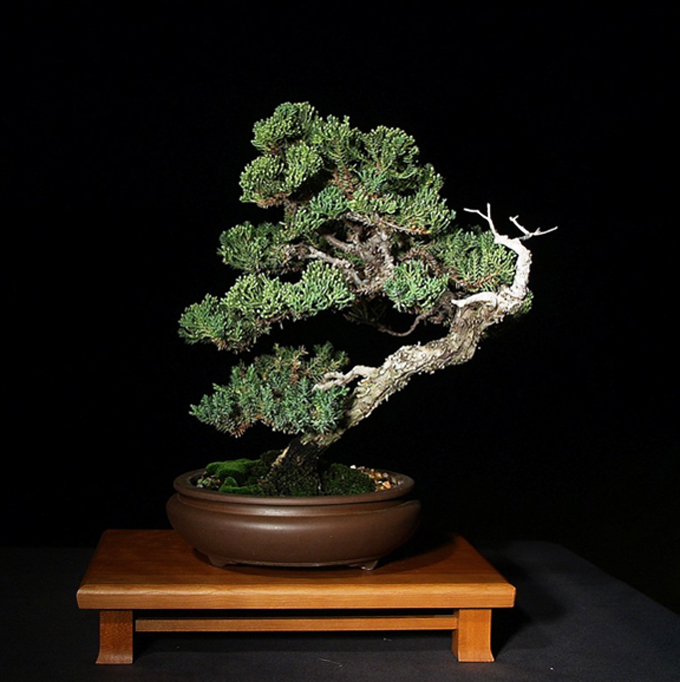 Maybe it’s not perfect, but given the limits of the variety (Jun procumbens ‘nana’), it’s pretty good. In fact, it’s one of the very best pro-nana I’ve seen. It belongs to Thomas J. Mozden, as do all but the last tree in this post. It’s from a 2009 contest that was held on The Art of Bonsai Project.
Maybe it’s not perfect, but given the limits of the variety (Jun procumbens ‘nana’), it’s pretty good. In fact, it’s one of the very best pro-nana I’ve seen. It belongs to Thomas J. Mozden, as do all but the last tree in this post. It’s from a 2009 contest that was held on The Art of Bonsai Project.
I was going to call this post Lone Star and feature the bonsai of Thomas Mozden who lives in Texas, but I got distracted along the way by the whole Juniper procumbens ‘nana’ question (see our ‘Not Shimpaku’ post and comments from last week).
My interest was originally peaked because this tough little plant was North America’s pioneer bonsai (aka Mallsai). Yet, for some reason, you seldom see older specimen quality examples. I think this mostly has to do with lack of impressive trunk girth (yet there’s that one glaring exception – see below), but perhaps something else is holding pro-nana back?
There are other questions swirling around this all too common but still mysterious variety, but we’ll leave those to Wikipedia for the moment. Except to say that some are a sort of blue-grey-green and some are bright green or even bright yellowish green, and I’m not sure why. I am sure however, that Pro-nanas (aka Dwarf Japanese garden juniper) in addition to once being our most popular bonsai, makes a very attractive and weed-resistant ground cover for landscaping, especially the ones with the bright green tint.
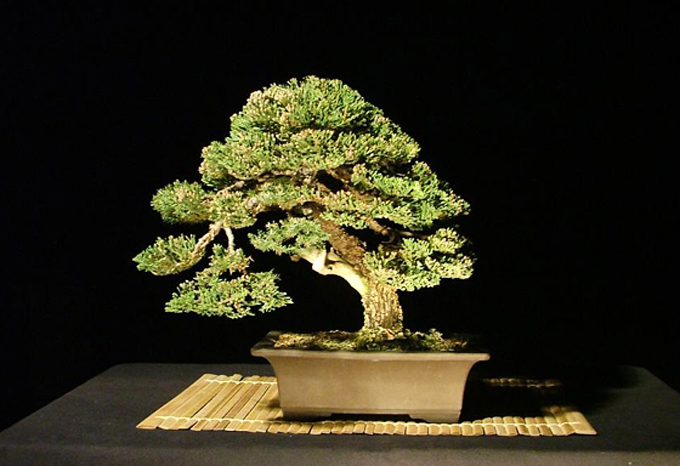 This one has trunked up fairly well for a Pro-nana. It’s another Thomas Mozden tree that appears on the Art of Bonsai Project.
This one has trunked up fairly well for a Pro-nana. It’s another Thomas Mozden tree that appears on the Art of Bonsai Project.
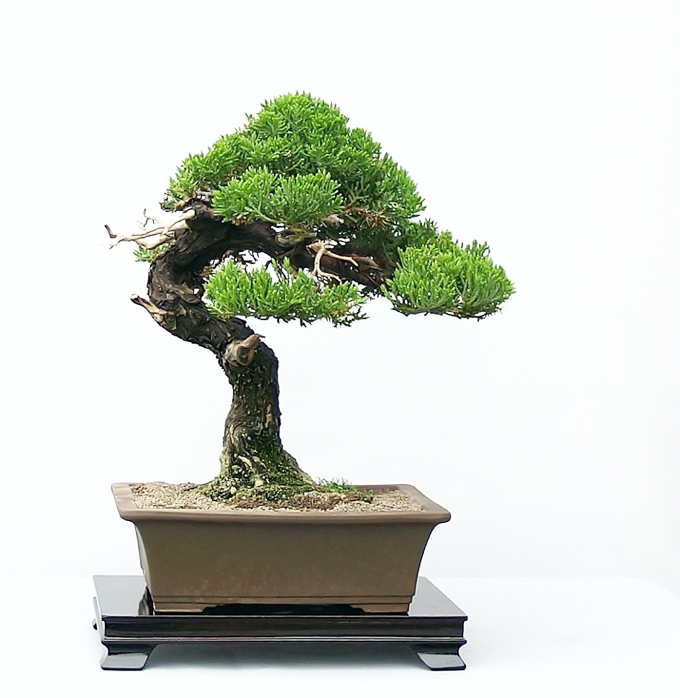 This one, also by Mr. Mozden, is from a contest that was held on the Art of Bonsai Project. The judges weren’t too excited about it (the unfinished looking soil surface no doubt didn’t help) but I think it has something. Some people might find that U-shaped curve a little problematic (those judges again) but it doesn’t bother me. A later more refined version of this little tree appears in our Not Shimpaku post from last week.
This one, also by Mr. Mozden, is from a contest that was held on the Art of Bonsai Project. The judges weren’t too excited about it (the unfinished looking soil surface no doubt didn’t help) but I think it has something. Some people might find that U-shaped curve a little problematic (those judges again) but it doesn’t bother me. A later more refined version of this little tree appears in our Not Shimpaku post from last week.
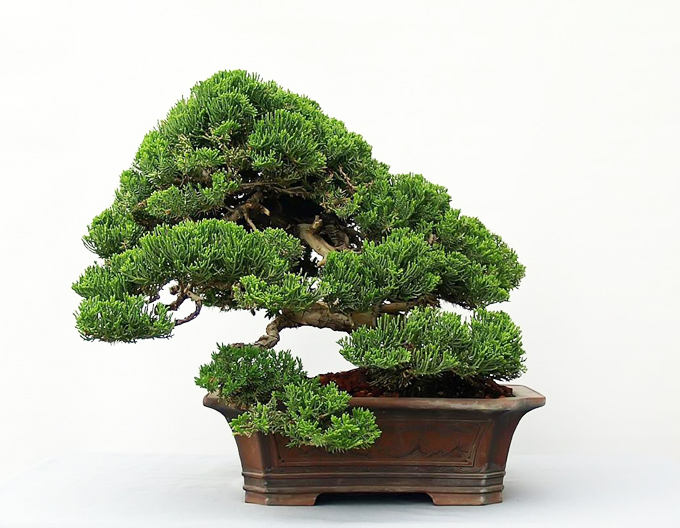 Unfinished potential. Nice overall shape and movement, but leaving foliage in front of the trunk’s base is very unusual and more than a little questionable. Is it hiding a flaw? There are also other spots that might look better with a little less foliage. Speaking of, this tree shows very little immature foliage, which is also unusual . Healthy Pro-nanas tend to show almost all immature foliage.
Unfinished potential. Nice overall shape and movement, but leaving foliage in front of the trunk’s base is very unusual and more than a little questionable. Is it hiding a flaw? There are also other spots that might look better with a little less foliage. Speaking of, this tree shows very little immature foliage, which is also unusual . Healthy Pro-nanas tend to show almost all immature foliage.
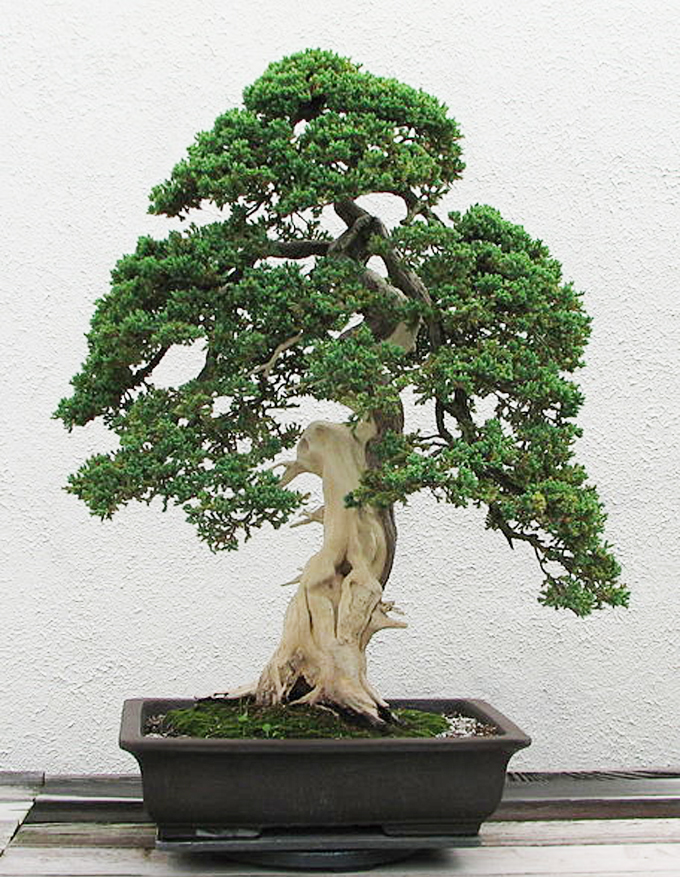 Like the second tree above, this one also appeared in our recent ‘Not Shimpaku’ post as well as on a post from last year. Here’s the caption: “This one is from a 2012 Bark post. The tree resides at the National Bonsai and Penjing Museum. It’s listed as a Procumbens nana, though I’ve never seen a ‘nana’ with such a massive trunk. Which begs the question…” In other words, is it a Phoenix graft? If you look at the other side, it doesn’t look like one to me, but maybe your eyes are sharper than mine (you’ll find the back and the back story on a post from 2012).
Like the second tree above, this one also appeared in our recent ‘Not Shimpaku’ post as well as on a post from last year. Here’s the caption: “This one is from a 2012 Bark post. The tree resides at the National Bonsai and Penjing Museum. It’s listed as a Procumbens nana, though I’ve never seen a ‘nana’ with such a massive trunk. Which begs the question…” In other words, is it a Phoenix graft? If you look at the other side, it doesn’t look like one to me, but maybe your eyes are sharper than mine (you’ll find the back and the back story on a post from 2012).
One of the reasons you tend to not see older, mature specimens is because J. procumbens (and cultivars, plus other needle-leaf varieties – San Jose, Rocky Mountain, etc – excepting J. rigidia) tend to be a handy and preferred host for half the Cedar Rust cycle. Shimpaku do not appear to be susceptible. The only juniper I keep now are shimpaku and rigida. I have no interest in fighting Cedar Rust annually.
At the Cincinnati Memorial this weekend, the question of J procumbens nana came up and the observation was they tend to form reverse taper as needles accumulate in the branch crotches and the trunk sends out roots into this duff. I have not seen this as a problem in my trees as I tend to keep them blown out. But, even so, I don’t see them putting on a lot of girth with increasing age.
I may be wrong, but I believe the reason most of us don’t care much for Pro Nana is like Wayne said in the post. They were sold in untold numbers by the “Big Box” retailers and, probably in a lot of cases, they were someone’s first (and probably last) experience with bonsai. I honestly believe that the absolute WORST thing that has ever happened in the bonsai world is when someone came up with the bright idea to mass produce these “Mall-sai” trees and sell them to people who had little to no chance of keeping them alive! Most people who buy these wind up having a bad first experience with bonsai and never try it again, even though it wasn’t their fault the thing died!
OK, thank you for letting me vent! Actually, Pro Nanas are one of my favorite trees to use for bonsai. They are just like anything else we use in the respect that you have to start with good material to make good bonsai, and to get good material, you have to know where to look. Steve Craddy at Plant City Bonsai in Clermont Ga. has a great supply of 40+ year old raw Pro Nanas that will blow your socks off! He is currently shipping them to clubs all over the country thanks to people like Ryan. Neal and several others who discovered them and have been spreading the word about them. Check Steve out at http://www.plantcitybonsai.com and see for yourself.
Wayne,
In Southeast Asia, Juniperus procumbens is still used. Look up ‘Sonare’ and you will find several examples. Also and in order to bury the misconception that what we know as Juniperus procumbens is a ‘nursery trade’ name, please visit this site:
http://conifersaroundtheworld.com/blog/juniperus_procumbens_japanese_mat_juniper
Regards,
Jose Luis
I have never seen a procubens nana with anything but immature foliage. I have my first three all in excess of thirty years old and there is not any mature foliage on any of them. Another fault I find is you have to spend hours every winter cleaning up all brown bits from last years growth. On the other hand after cleaning them up when healthy they are quite beautiful .
Qualicum Brian
The final tree shown from The National Bonsai and Penjing Museum ” In other words, is it a Phoenix graft?” To which I reply “who cares”. I have seen this tree and it is a spectacular bonsai.
Greg,
The answer to your ‘who cares’ turns out to be lots of people. My view is probably closer to yours, if it’s beautiful, exciting, powerful, soulful or whatever, then why not?
Thanks Brian,
I have seen mature foliage on pro-nanas in southern Florida where they are most likely stressed due to lack of winter dormancy. On the other hand, I’ve seen pro-nana that are grown indoors year round, where you’d expect the same kind of stress, with all immature foliage. Unhealthy for sure, with poor color and almost no growth, but still alive. Tough little plants.
Wayne,
I’m not sure that a ‘stressful’ scenario will trigger mature foliage. On the other hand and based on past experience with other juniper species, disturbances in the trees structure will result in just the opposite; revertal to juvenile form.
In the link i provided, the botanists explore the phenomenom of mature foliar form in Juniperus procumbens in their native/natural terrain. Some trees displayed needle foliage. Others, a combination of both. In contrast, some specimens displayed 100 % scale foliage. Being a coastal area, where the salt spray and coastal wind will hinder the occurrence of snow in winter, i will tend to believe that these specimens are not that exposed to snow and ice.
Comparing such climate with that of a tropical zone, the only common denominator is stable temperatures. My Juniperus procumbens only display mature foliage. The do exhibit needle form, but only when I hard prune a branch or debark a section for jin or shari. In the latter case a needle foliage thuft emerges right near the debarked portion.
Regards,
Jose Luis